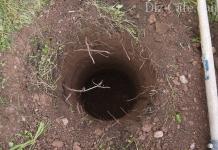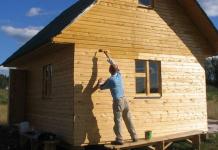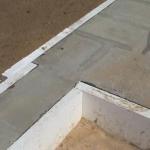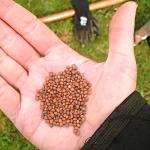A year after building the house, I wanted to attach a canopy to its front wall. So that it is functional, but at the same time very simple in design. What was required from the canopy? The most important thing is that thanks to it I wanted to get an additional place for summer relaxation, protected from sunlight and rain. For outdoor gatherings, so you can have lunch in the courtyard and relax on a sun lounger. According to the project, the canopy was supposed to be a kind of replacement for an open gazebo, but with a simpler design. So that during construction a minimum of material resources and physical effort is spent.
Within 2 weeks the plan was implemented. Based on the acquired practical skills and knowledge, I would like to bring to your attention a report on the construction of the simplest classic canopy attached to a house.
The design chosen was standard for this type of canopy. This is simply a roof truss system on supports. The dimensions of the canopy in plan are 1.8 x 6 m, the height to the roof is 2.4 m. On one side, metal pillars (4 pieces along the facade) are used as a supporting element, on the other, a board screwed to the wall of the house. The roof covering is Ondura sheets (analogous to Ondulin, with larger sheet sizes). It is planned to install lattice bars between the pillars so that you can sit in the shade under a canopy, enjoying nature and fresh air, even in the midday heat.
So, I’ll start the story about how this idea was realized. I hope I can clearly describe the whole process.
Step #1 – installation of metal poles
I started by installing metal pillars, that is, the vertical posts of the canopy, which will support the roof truss system. There are only 4 of them, they run along the facade, at a distance of 1.8 m from the wall. According to the plan, the length of the canopy is 6 m (along the entire length of the facade of the house), so the pitch of the racks is 1.8 m (taking into account the roof extensions on both sides of the racks).
For the racks, 4 steel pipes of 60x60x3 mm square section with a length of 3.9 m were purchased. They will be buried 1.5 m into the ground (below the freezing level), 2.4 m will remain on top. This will be the height of the canopy.
First, I marked with pegs the places where the posts should be installed - strictly at a distance of 1.8 m from the wall. I measured everything and calculated the horizontal lines. Then I took a drill with a 150 mm nozzle and drilled 4 holes 1.5 m deep.

According to the planned program, a concrete pile foundation will be poured under the racks. This is done as follows: each rack is installed in a pit into which concrete is poured. The result is reinforced piles holding the posts.
It is not advisable to pour concrete directly into drilled holes. It is necessary to make insulation, which will simultaneously serve as formwork. To do this, I decided to use roofing felt sleeves - sections of roofing felt rolled into a cylinder. The length of the sleeves should be such that the concrete piles protrude 10 cm above ground level. For a pit 1.5 m deep, at the bottom of which a 10 cm sand cushion will be poured, sleeves 1.5 m long are required. The diameter of the sleeves is 140 mm.

Concrete poured into roofing felt sleeves holds metal posts
I cut pieces of roofing felt, rolled them into sleeves and fastened them with tape (you can use a stapler). Next, a 10 cm layer of sand was poured into the bottom of each hole and a sleeve was inserted there. The concrete formwork is ready.
Metal stands were installed in the sleeves. First - the two outer ones, I aligned them vertically and height (2.4 m), pulled a cord between them and placed two intermediate posts along it. After which I poured concrete into the sleeves (from the ready-made mixture, just added water and that’s it - very convenient).

I allowed 3 days for the concrete to set and cure. It is not advisable to load the racks during this time, so I started preparing the wooden parts - support boards and rafters.
Material on how to build a terrace will also be useful:
Step #2 – making the roof
The roof structure includes 2 support boards on which the rafters and the entire roof structure will be supported. One of the boards is mounted on the wall, the other on posts. Rafters are laid on top of the support boards, in the transverse direction.
The boards were taken with a section of 150x50 mm, 6 m long. Since the canopy was originally planned as a solid but inexpensive structure, I bought unplaned boards. I planed and sanded them myself, which took some time. But I was confident in the result and smoothed the surface to the highest standard.
The rafters will be laid in the grooves of the support boards. Another headache - you need to cut the grooves, and at the angle of the rafters. To determine the angle and insertion locations, we had to perform a test installation of the boards. I screwed such a board to the wall with 140x8 mm wood grouse, and to the metal posts with 8 mm studs using washers and nuts.

Now that the support boards are in place, a small tool was used, with the help of which I determined the angle of inclination of the rafters. After which the boards were removed and grooves for the rafters were cut into them, taking into account a known angle.
The rafters are also made of boards 150x50 mm, 2 m long. There were 7 rafters in total. Their installation step on the support boards is 1 m.
After fitting the rafters to the grooves, all parts were painted with Holz Lazur JOBI glazing compound in teak color.
Then everything was installed. Support boards - as during preliminary fastening, that is, with the help of wood grouse and pins. The rafters were laid on top, in the grooves of the boards, and hammered in with nails. Each groove required 2 nails driven through the rafters obliquely, towards each other.

For the sheathing under Ondura we used 100x25 mm boards, 6 m long - 7 pieces. I screwed them across the rafters with self-tapping screws.

Ondura sheets are laid on the sheathing and nailed with rough nails with plastic caps to match the color of the flooring. In fact, the roof is already ready, now you don’t have to worry about rain and arrange a place under a canopy. For example, bring a garden table and chairs there.

Canopy covered with sheets of Euro slate Ondura
The ends of the rafters remained open, which is not very good in terms of decorativeness. And there was nowhere to attach the drain. Therefore, to complete the roof, I screwed a 6 m long frontal board - clapboard - to the ends of the rafters.

The front board covers the ends of the rafters and creates support for the gutter
The next stage is fixing the drain. Two 3-meter drains are mounted on the front board. The drainage from the roof goes into a watering pipe through which the grapes will be watered.
Step #3 – pouring the foundation for the mini-wall
To prevent water from getting under the canopy during rain, I decided to make a low brick retaining wall between the posts. It requires a strip foundation, which I made using standard technology. I dug a trench between the supports using the bayonet of a shovel and set out the formwork from the boards. I poured a 10 cm sand cushion at the bottom of the trench. And on top of it I placed 2 reinforcement bars on supports to fasten (reinforce) the foundation.
I was afraid to do it without reinforcement, you never know, it might crack and fall apart. Then he mixed the concrete and poured it into the trench. It was necessary to wait until the concrete set and hardened, so I decided to return to the supporting wall later. And now – start decorating your building.
Step #4 – installation of covers on posts and trellises
It's time to look at the canopy with a critical eye. The metal uprights of the canopy stood out a little from the overall composition. I decided to decorate and refine them by sewing them with wooden overlays. Just for this I have a few 100x25 mm boards left. I secured them on top of the metal posts using pieces of M8 studs, washers and nuts. There was space left between the overlays (on the side where the trellis was installed), so I inserted a 45x20 mm rail there. The slats formed protrusions; the horizontal elements of the trellis will be attached to them.

The time has come to attach the trellises. I chose a lattice pattern for them with a carved hole in the center. This hole allowed me to use not only long slats for the trellis, but also trimmings. We can say that it turned out to be a waste-free production. And this pattern looks more interesting than standard monotonous squares.
The slats for the trellises were made by longitudinally dissolving the 100x25mm boards I had. The board was split into three parts, and the resulting slats were sanded. The final cross-section of the slats (after grinding) is 30x20 mm.
I made the trellises without a frame; the slats are attached only to the vertical protrusions of the posts. At first, I set up horizontal slats, screwing them to the protrusions with self-tapping screws. Then, vertical slats were secured on top of them. The result was a decorative trellis, near which the wife planted grapes. Now it is already winding with might and main along the trellis and has almost blocked the wall of the structure. The shade protects from the midday heat. This is very useful, since the canopy is located on the south side of the house and without a canopy it was almost impossible to rest here during the day due to the abnormal heat.
Material on how to attach a veranda to a house will also be useful:

Trellis are assembled from slats directly “on site”

Step #5 - building a retaining wall
The last stage is the construction of a retaining wall. The strip foundation under it has already frozen, work can begin. For waterproofing, I glued 2 layers of roofing felt to the foundation tape, coating each layer with mastic. On top, along the roofing felt, I built a level retaining wall, 3 bricks high.

The retaining wall will not allow raindrops and water to fall onto the area under the canopy during irrigation.
Now there will be less dirt when watering and raining. And the canopy looks much nicer this way.

That's probably all. The shed was built. I implemented the entire project alone, but I did not notice any difficulties in the process. Subsequently, the area under the canopy was covered with paving slabs. You can say that I have a covered terrace or an open gazebo - whatever you like, call it that. Although in terms of design, this is an ordinary canopy on poles, the construction of which took very little time.
In order not to get wet in the rain and not languish in the sun while you open the front doors, you need some kind of protection. Usually they make a canopy over the porch or just over the door. In some cases, the canopy may also cover steps and even a path or part of it. How to make such a structure, from what materials we’ll talk further.
Species and types
If we talk about the structure as a whole, the canopy or canopy over the porch consists of a frame and roofing material (cladding). There may also be support posts that support the outer edge of the canopy. They are an optional element. They are needed when there is no confidence that the structure without additional supports will be able to retain precipitation.
Precipitation generally means snow. In regions with a lot of snow, you can either make the slope of the canopy steep so that the snow melts quickly, or install additional supports. You can do both, as is usually done - the margin of reliability/strength reassures and instills confidence.
Frame and stand materials
The frame and supports of the canopy over the front door are made from:

The most popular material recently for making the frame of a canopy over a porch is profiled pipe. With equal dimensions and wall thickness with a round pipe (if we compare the diagonal and diameter), the profile has greater rigidity. At the same time, it comes in a variety of sections - a square and a rectangle with different sides, it can be bent into arcs, it is easier to weld and attach to walls, it goes well with elements of traditional or cold forging, and its durability is the same as other steel products. In general, it is the profiled pipe that is in favor today.
What is the lining of the canopy over the porch made of?
If we talk about materials for cladding the canopy over the porch, there is a very wide choice. Very often the canopy over the entrance to the house is made of the same material as the roof. And this is correct, since in this case the result is a harmonious design of the house. With this solution, any roofing material is used:
The second option is to use the material that is used in the fence. In this case, both the design style and decorative elements should be recognizable. This will create a single ensemble with the site. Here the materials can be like this:
- slate (usually flat, but not a fact);
- corrugated sheeting;
- polycarbonate;
- wooden plank.
And the third option for designing a canopy over the porch is to install a canopy that is “neutral” in style and material. This may include:
Glass is used less often. It is necessary to use reinforced types such as triplex, and not only are they expensive, they also weigh heavily, so additional suspensions or powerful support columns are definitely required. And if you consider that sheet polycarbonate or plastic is not much different in appearance from glass, it becomes clear why glass is unpopular.
Shapes of canopies
There are more than a dozen forms of canopies over the front door. The easiest one to make is a lean-to canopy. Requires a minimum of effort and materials, and can look very good. The downside is that when the snow melts, a snowdrift will end up in front of your door and will urgently need to be removed. Other models with slopes tilted forward suffer from the same “disease”. These are excellent options for regions with little snow in winters, but with hot sun - not quite for our latitudes. Although, if you are not afraid of the need for urgent snow removal, you can do any of the options.

It’s a little more difficult to make a gable canopy (this is the house) and a simple arch. They are good because the melted snow ends up on the sides of the entrance and, even if there is a large amount of it, there is no need to urgently remove it. So for regions with a lot of snow, these are the best models.
How to connect the canopy over the porch and the wall of the house
One of the most difficult moments is to join the covering of the canopy over the porch so that water does not flow down the wall. Usually, standard methods of joining the roof are used - using a bumper strip. This method is suitable for any roofing material, as well as sheet metal and wood. You just need to choose the right color. There are two approaches: matching the wall or matching the roof covering of the canopy. The options are equal, so it’s up to you to decide/choose.

A groove (5-7 mm deep) is made under the fender strip in the wall. The edge of the plank is inserted into the recess, secured, and the seam is sealed with moisture-resistant sealant for external use. The other edge of the strip rests on the roofing material. When water runs down the wall, it flows onto the plank, from it, bypassing the joint, onto the roofing material and further into or directly onto the ground - depending on how it’s done.
If you use metal tiles, sellers have a special wall profile. It can also be used with other materials - it is important to choose the color. The standard unit includes rubber seals, which are placed a couple of centimeters from the outer edge. In this case, during strong winds, water and debris do not fall under the bar.

If the canopy over the front door and porch is made of polycarbonate, glass or sheet plastic, the method described above is unacceptable - it looks too rough. In this case there are two options:

There are no other good options. You can only combine both proposed ones for reliability.
How to fix if the wall is multi-layered
Recently, more and more buildings have multi-layered external walls - ventilated facades, insulation... The load-bearing part of the wall turns out to be covered with a couple of layers of materials, the load-bearing capacity of which is only enough to hold its own weight. You won't be able to attach anything to them. The entire load must fall on the load-bearing wall.

Even if the outer layer is a finishing brick, it costs nothing to attach to it. Masonry is usually carried out in half a brick. So it only looks durable on the outside. Even the smallest and lightest canopy cannot support the weight, and the supporting columns do not help either.
Therefore, with any multi-layer wall, holes are made in all finishing/insulating layers, and the structural elements are attached to the load-bearing wall.
Single-pitch canopy: design features
An inclined or straight single-pitched canopy is the simplest thing that can be. We rarely see straight ones - they are not very functional, but there are quite a lot of single-slope inclined ones.
The inclined single-pitch canopy is based on a right-angled triangle. A right angle is adjacent to the wall, and the length of the sides depends on the desired slope.

In the simplest case, you can weld three identical triangles from a profiled pipe (as in the figure above), make holes in them for fasteners (at least three). These three elements can be combined into a single whole using sheathing for roofing material - as in the figure. Or you can weld cross members from the same pipe (but of a smaller cross-section) or a strip or corner. This option - with metal jumpers - is more suitable for a canopy over a porch made of polycarbonate or plastic. It is also good for metal sheets - it will be convenient to weld it or screw in self-tapping screws.

There is also an option with a variable tilt angle. This is a rectangular frame with sheathing lintels to which lightweight roofing material is attached. This frame is attached above the entrance using a wall beam fixed to the wall (we described how to make the connection above).

Depending on the required angle of inclination, struts are made. They can be made of metal or wood. Fixed to the frame.
If desired, this option can be made with an adjustable tilt angle. Make the fastening of the frame and struts to the wall movable (on hinges, for example), make several holes in the frame. By rearranging the struts into different holes, you can get a different angle of inclination. This feature is not very relevant for doors - except for glass ones - to block out too bright sun, but for windows it can be useful.
Gable canopy frame
There are at least two ways to assemble a canopy with two slopes: from two or more (depending on the length of the canopy) triangular rafters or from two rectangular frames with sheathing, secured with crossbars. The second option is shown in the figure below, and the first will be a little further.

A canopy with a house is one of the popular options
Method one
Two quadrangles are assembled from a timber or thick board, which are united by a ridge board. The angle of inclination of the slopes is set by cuts on the ridge, fixed by crossbars - a spacer bar. Since the roofing material is laid from the ridge down, the sheathing strips are laid in the opposite direction. A continuous flooring is required under soft tiles. It can be moisture-resistant plywood or.

Also, brackets are assembled on the ground - stops that will transfer the load from the canopy to a large area of the wall. It is better to assemble the structure on the ground (without fastening the roofing material). In order to lift and secure the canopy, assistants or the services of a manipulator will be required.
Method two
The second option is the assembly of individual rafter structures. Maybe this option will seem easier to you - all gable roofs are assembled according to this principle.

Here, too, a frame is assembled from timber and brackets are needed. But the frame lies in a horizontal plane, supported by brackets. Two or three triangles are assembled from rafters, which rest on a ridge beam, and it rests on a post, the other end of which is fixed to the frame. It turns out a mini-model of a conventional rafter system.
To improve the appearance, bevels are placed near the counter. In the photo above they are curved, but this is far from necessary. You can simply make it from timber, sawing it at the desired angle. It is also better to assemble the system on the ground - it will not be possible to connect it smoothly at a height.
Made of metal
If the canopy frame is made of a metal pipe, everything is much simpler. The pipe has a high load-bearing capacity, so there are much fewer supporting and auxiliary elements.
Two identical triangles are cooked - according to the size of the future canopy. They are connected by jumpers, the length of which is determined by the “depth” of the visor. To prevent the cladding from bending, additional crossbars are welded.

The finished canopy structure is complemented by brackets - stops. In the picture above, the canopy over the porch has only a stop without slopes. For regions with little snow in winter, this is enough, but to hold a significant mass of snow, you will need a mow or stand. Or maybe both (as in the diagram below).

Decorative elements are an optional part. There may be an ordinary triangle here.
Arched canopy over the porch: manufacturing features
A canopy over the front door in the form of an arch cannot be called difficult to manufacture. It is more convenient to make this shape from a steel pipe, and from a profile, rectangular section. Using (you can do it manually, but it’s more difficult) you make several arches of the same size. They are connected by jumpers, the length of which is determined by the desired size of the roofing part.

Arched design is the simplest option
The first and last arches are connected by horizontal jumpers; brackets or, as in the figure above, ordinary stops are welded to the last one.
You can often see double arches with decorative and not very decorative filling. They are typical for large structures. Still, the windage and snow load turn out to be large and it is better to play it safe by making a safety margin than to do everything all over again.
Photo ideas






The canopy over the porch is not only over the front door, but also over the terrace too

Wooden canopy over the entrance in the form of a house - options with support pillars under the tiles

Sometimes a farm may need a large wooden shed measuring 6 by 20. This could be a shed for parking several cars, in order to cover a production site or a storage area for building materials. Sometimes it can be simply a canopy attached to the house and stretching along the entire wall in order to simultaneously cover a passage, passage, parking area, resting place or storage area for equipment. If the canopy is attached to the house, then the most convenient roof structure with such dimensions is a lean-to roof.
Order a canopy?
We make canopies from polycarbonate and glass.
There are promotional carport prices - turnkey carport 3.6 x 6.3 = 63,000 rubles!!!
turnkey carport for 2 cars 5.7 x 6.3 = 128,000 rubles!!!

A canopy, even of this size, is not the most complex design, but it definitely requires accurate calculation to create an effective slope angle and select the best material for the roof so that it does not break in winter under the weight of snow. The supporting frame must survive any storms characteristic of the region, otherwise, if errors were made in the calculations, it may simply collapse.
Selection of building materials
To create a strong and reliable structure of this size, you will have to spend money on structural elements. You will need:
1. Support pillars with a cross-section of at least 150 by 200,
2. beams of the same section (their number depends on the length, the beams will have to be spliced),
3. rafters with a cross-section of at least 100 by 150, preferably 200 by 100, depending on the snow load of the region. The pitch between the rafters must be calculated based on the roofing material. If you plan to roof from polycarbonate, then the step needs to be taken more often, 0.7 m. When covering with corrugated sheets, the step can be increased.

The minimum slope of the slope should be at least 12 degrees, or better yet more, so that the snow can easily slide off the roof. The material for the roof should also be taken according to financial capabilities, preferably not rough, so that it does not slow down the sliding of snow.

A minimum slope is created by building walls opposite each other of different heights. For example, to create a slope of 12-13 degrees, the length of the supports should correspond to 3.7 m at the point of attachment to the house and 2.6 m at the lower point of the opposite row.
Support arrangement
When marking the area for the canopy, it is necessary to take into account that the extension from the outside of the roof should be equal to 20 cm. Based on this, along the wall to which the canopy will adjoin and opposite, the installation locations of the support pillars are marked. For example, you can take a step of 3 meters between the pillars. Concrete foundations must be poured under the support pillars. The support column can be immersed in concrete, having previously treated it with anti-rotting impregnations and wrapped in thick polyethylene. You can use embedded parts - anchors. Anchors can also be dismantled and sunk directly into concrete. To create a concrete foundation, a hole 90 cm deep is enough.


The supports are screwed to the anchors with anchors. First, a row is installed near the wall of the house. Then the second outer row of supports is installed. The supports must be installed strictly opposite each other, strictly vertically and aligned to the required height, taking into account the planned slope. That is, the supports near the wall should be higher than the outside ones.

Frame structure
Supporting horizontal beams are attached to the support pillars. You also need to start work from a row from the wall.

The beams are laid on support pillars and spliced together with metal plates. After the horizontal level has been checked, the beams are fastened with self-tapping screws to the support pillars and with the help of fasteners to the wall of the house.



To create a more durable structure, the beams on the opposite side are additionally reinforced with spacers in both directions at an angle of 45 degrees from each support column. The spacers are also attached with self-tapping screws.

The crossbars can be mounted using self-tapping screws, or using metal mounting angles. Beams from the edges are installed first, then in the center, then the rest.

The offset should be at least 20 cm. Lastly, the end board is placed on the ends of the boards.

For greater strength, you can strengthen the outer beams with rafter legs. To do this, a beam is attached to the supporting pillars on the side of the wall at the level of the end of the pillars on the opposite side at an angle of 45 degrees, which will hold the rafters and roof in the winter, when there is excess snow weight.
Making a wooden canopy with your own hands is not at all difficult. In just a few days you will have an excellent design that will protect firewood, grain, a car, and a barbecue from precipitation. In order to save a lot of time, money and effort, it is necessary to develop a clear action plan. This is what we will do in step-by-step instructions.
Installation of supports - the basics
First of all, we need to think about what our structure will be supported on. Some craftsmen recommend simply installing wooden logs on the ground, onto which you can then nail the sheathing, reinforcements and roof. You can do this, but where is the guarantee that tomorrow it won’t rain and blow your canopy 50 centimeters away? Wet and loose soil is the main enemy of wooden structures installed on the ground.
That is why we will only consider supports installed on a concrete base. This is the only way the structure will be level after any rainfall. Let's start our construction from the "foundation", if you can call it that, and look at the step-by-step instructions for pouring it.
Step 1 Dig a hole.
To save concrete, we make a round columnar foundation. You can rent or borrow a hand drill from a neighbor to make holes with a diameter of 35 to 60 centimeters. 35 will be enough. The main thing is the depth, which cannot be less than 50 cm - this is necessary to avoid possible subsidence on loose soil. No drill? We take it and dig.
Step 2 Pour the foundation.
It is important for us to obtain a high specific gravity of concrete, and not its strength characteristics. Therefore, we mix 1:4 with sand and add another 3 parts of coarse crushed stone to bind the materials. Make it very rare and pour it into the hole.
Step 3 Make a base.
It is necessary to raise the foundation 10 centimeters above the ground so that the wood does not touch the wet soil. You can do it this way: select a suitable metal barrel according to its diameter (a 3-liter paint can will do), place it on top of the foundation and fill it with concrete. Remove after 2 days.
All that remains is to simply install wooden poles with a diameter of 20-30 centimeters and initially tie them together in a heap with the bottom strapping at the level of 80-90 centimeters. High precision is not necessary; you can estimate by eye the evenness of the pillars, since then we will measure with a level when installing the top trim.
Lathing, strapping, anti-corrosion treatment of frame
To make a canopy at the dacha with your own hands from wood, you need to master the level - this is the main tool. It will help make a smooth structure. Since the wooden log (25 cm in diameter) will be rounded, its shape is close to ideal, so leveling will be easy. Let's look at step-by-step instructions on how to properly make a harness.
Step 1 Align the pillars.
Take a level and lean it vertically against the support. If everything matches, then you can pile up the first 2 supports. After this, we lean the level again and measure. Repeat the procedure every time a new column is added to the bundle. After you have tied everything together, you need to measure the angle of inclination of the structure in all directions, since after nailing the rafters it will be too late.
Step 2 We install the rafters.
The easiest way is to make a lean-to building, then the rafters just need to be laid at an angle of 1 slope every 70 centimeters. But when constructing a gable roof, you will have to take into account another ridge. Using a plumb line and a tape measure, we determine the middle of the room, raise the vertical and attach the ridge to 2 slats. Next, we adjust all the rafters to it at an angle of 45 degrees. This is the ideal angle for a 4x4 meter canopy. Make lathing every 50 centimeters from 35x55 timber.
Step 3 We treat everything with anti-corrosion suspensions.
You can use standard wood stain and varnish, but we recommend treating with exterior stone varnish. It is characterized by maximum penetration into the material, protects the board for many years and protects against biological corrosion.
Pro tip: it is recommended to leave the rafters 30-45 centimeters after the top trim, since moisture can get on the wood during strong winds or snowfall. No matter how good the protection of the tree, it will still rot if it is constantly wet.
Roofing installation
If you don’t know how to make a wooden canopy with your own hands, and what kind of roof to install, then it’s worth evaluating all the advantages of the materials offered on the market. As a rule, to save money, ordinary slate, metal tiles or profiled sheets are used. The latter cost very little, are durable and are easily attached to the sheathing. Let's take a closer look at their installation!
Step 1 We measure.
Lay several sheets and check with a level along the bottom edge so that nothing is mowing. It can be attached with a self-tapping screw so that the material does not “run away” anywhere during its measurements.
Step 2 Screw it on.
Using the help, we make 2 holes per 1 sheet, and we must drill immediately with the sheathing. Then we take M8 bolts and nuts and attach them. We measure everything and only then tighten it with wrenches. It is advisable to use special plastic washers for the outside to limit moisture and seal the sheet well.
Step 3 We cut off everything unnecessary with a grinder.
If somewhere there is a corner on the last row or the skate does not please you with its curvature, you can trim it with a grinder.
If you do everything correctly and constantly measure the slopes, then you won’t have to level anything, the sheets will all become as they were.
Wooden awnings for a summer residence are one of the simplest designs where you can safely experiment, because even if something goes wrong, everything can be redone quickly and not difficult.
You may need a variety of awnings at your dacha: over a porch, a bench, a barbecue and a tennis table, over a parking lot and a woodshed. They can be built from wood or metal profiles.
In this article we will offer you different options for inexpensive and easy-to-build shelters for the purposes mentioned. The main points and features of construction, both metal and wood, will also be mentioned here.





Varieties of the most inexpensive awnings for a summer residence. Construction Features
The options for canopies and shelters described below can even be made from used pipes or lumber left after repair.
Canopies over the porch
The simplest and cheapest option for building a country canopy with your own hands is a lean-to structure with an independent roof that does not require the installation of support pillars. It consists of several triangular trusses, which on one side provide fastening of the structure to the wall. The second side - the top - is the basis for installing the sheathing and roofing material. Such trusses can be assembled from either a metal profile or wood.
Note: The main advantage of an independent roof is that you do not have to change the design of an existing porch by installing support pillars on it. We also don’t forget about saving money on materials and time on installation work.
Drawing of a visor that does not need stands
The second option for a porch canopy at the dacha is a design with a dependent roof. Here one side is tied to the house, and the other rests on the posts. It will be cheaper and easier to make a lean-to structure, as in the photo. In essence, it is a square or rectangle with several lintels and two support pillars. It can be assembled in the same way as an independent roof, from wood or metal profiles.
This design has one advantage: the support posts can become a frame for mounting on the sides of the windproof panels. That is, if you wish, you can make the porch closed, completely or partially. Disadvantage - when building a canopy, you will have to allow additional time for the solidification of the columnar foundation under the support posts.

We make a canopy at the dacha with our own hands: photo of a building with a dependent roof
Canopy for a bench in the country
The most budget-friendly option for a dacha canopy over a garden bench is a tension one. It is assembled literally from scrap materials. Two pieces of profile pipe, preferably round in cross-section, are bent with a kind of hooks and concreted with straight ends behind the bench. A strip of thick fabric is pulled onto the hooks, which forms a canopy. If you take pipes that have already been used, then such a shelter will be practically free. The only drawback of the design is that the fabric roof will not protect from heavy rain.

How to make a canopy at your dacha for relaxation: building with a tension awning
A more expensive type of canopy for a dacha, but more “major” - polycarbonate on a frame made of metal profiles or wood. The easiest way to assemble a pitched roof is to assemble an arched, rectangular or square roof if you have a pipe bending machine. It is best to make awnings for a summer house from polycarbonate - the material is easy to install and does not require preliminary lathing of the frame. You can also use slate sheets - they are just the right size and, moreover, will be cheaper.

Simple awnings for a summer residence: photo of a polycarbonate canopy
Canopy for a tennis table and barbecue in the country
We have the following requirements for a canopy at the dacha for relaxation, located above the tennis table:
- Sufficient roof height.
- The distance from the table to the support pillars is at least 1 meter.
- Good light transmission of the roof.
The best option is a lean-to canopy with polycarbonate as a roofing material, with a simple frame. You can, of course, use slate or something similar, but in this case you will have to spend money on installing lighting above the table. This negates the financial benefit of replacement.
For your information: It’s hard to say which is more profitable, wood or metal profiles. It all depends on how important the aesthetic side of the issue is to you. If you just need a strong frame, and its appearance is a secondary matter, then it will be cheaper to use a simple beam. A beautiful rounded log will be quite expensive, even more expensive than a good profile pipe. The same applies to profiled timber - this pleasure is not cheap.
Tennis table cover
The main function of a canopy over a barbecue in a country house is to protect the fire from precipitation and wind. Therefore, the roof here should be either arched or gable. At the same time, there should be at least 40 cm from the container with coals to the edges of the slopes on one side and from 1 m on the other. The simplest option is a gable frame on four supports. It’s better to make a canopy for a barbecue at your dacha with your own hands from metal profiles or pipes. Wood is not very suitable here for fire safety reasons.

Option for a canopy at the dacha for barbecue or barbecue
Canopy for car and woodshed
An inexpensive and simple version of a carport for a dacha is a lean-to carport, one side resting on the wall or edge of the roof of the house, and the other on the posts. The design is elementary: 2-4 support pillars, a beam/beam connecting to the house and a rectangular roof frame with lintels. Any roofing material can be used:
- Slate or metal tiles - with them you can build a relatively inexpensive carport at your dacha with your own hands. This will require preliminary organization of the sheathing.
- Ruberoid roofing is the cheapest option, but it won’t last too long. In addition, you will have to make a hard substrate under it.
- Carports for cars in the countryside made of polycarbonate - the material is easy and quick to install and does not require lathing. But it will cost more than the first two options.

Carport at the dacha: photo of a lean-to attached structure
A little more difficult to construct and more expensive in terms of consumables is a free-standing carport in the country. It can be on a columnar foundation or without it at all, as in the photo. Here, each truss is immediately welded onto racks, and then the entire structure is assembled on horizontal sections of profile pipe. The advantage of such a canopy at the dacha is mobility.

Photo of a carport at the dacha: a gable building without a foundation
Note: There are not many options for building sheds for firewood at your dacha with your own hands. Here, in addition to the roof, in any case, you also need back and side walls that will protect the contents from precipitation. At the same time, there must be ventilation inside. Therefore, the optimal design here would be a gable roof, on four support pillars and with a number of intermediate ones. Additionally, the walls are covered with boards with small gaps between them.
Wooden woodshed
Wooden and metal canopies at the dacha: construction features
When building sheds, either wooden or metal, several main points can be highlighted:
- The construction of a columnar foundation, with or without reinforcement - it all depends on the dimensions of the building.
- Installation of support pillars. They are either concreted immediately or attached to a ready-made foundation.
- Assembling the roof frame on the ground.
- Installation of the roof on supports.
- Treatment with an antiseptic – for wood, treatment with anti-corrosion compounds – for metal. Antiseptic treatment for wood is very important, since the duration and trouble-free operation of the building directly depends on it.
Stages 2, 3, and 4 must be carried out under constant control by the construction level.
For your information: Even if the profile has an anti-corrosion coating, this protection will not be available at the welding points. Therefore, such points should be properly processed. First, we clean off the scale and go over the metal with emery, and then we coat the welding seams with an anti-corrosion compound.
After you have built a canopy at your dacha with your own hands, all welding seams must be cleaned and treated with anti-corrosion agent




















